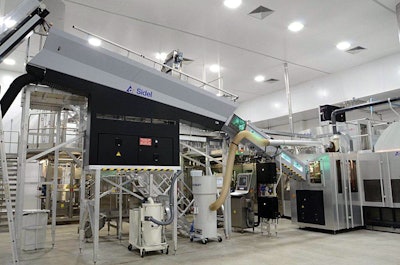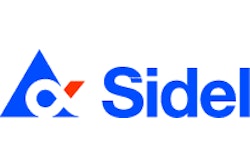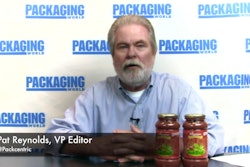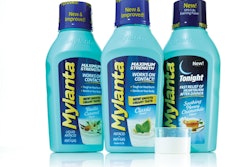Brazilian company Jussara has become Latin America’s first-ever dairy producer to adopt an aseptic blow/fill/cap solution equipped with dry preform decontamination. With this Combi Predis FMa solution from Sidel, Jussara expands its portfolio with a new PET bottle to differentiate its brands on the shelves in a market dominated by shelf stable cartons. The first milk to be bottled using this technology, a UHT milk that is shelf stable for four months, is enriched with added calcium and vitamins. Branded as “Jussara Max,” the 1-L bottles have already received positive reactions from the Brazilian consumers.
In 2013, the Brazilian market consumed 6.3 billion L of shelf stable UHT milk, which makes Brazil the largest consumer of UHT milk in the world. UHT milk is the main type of milk consumed in Brazil, with a 60% share of the drinking-milk market, against 13% for refrigerated pasteurized milk and 27% for milk powder. UHT milk consumption grew 4% last year and is still gaining market share, with over 90% penetration in Brazilian homes.
In this very dynamic market, the family-owned company Jussara is the ninth largest producer of dairy products in Brazil, with continuously growing total sales and currently ranking fifth in terms of the Brazilian UHT milk market. In looking to extend its portfolio of products, Jussara wanted to meet consumer demand in terms of innovative products with special formulation and function. Management identified user-friendly packages that are easier to handle and to store as a golden opportunity. After more than a year of investigating the potential options and a long period of discussion with Sidel, a leading global provider of PET solutions for liquid packaging, Jussara decided to invest in a new production line for its premium UHT milk. The decision was taken to introduce innovative and different packaging—drawing on the flexible design possibilities that PET delivers as a material—to offer greater brand recognition for the consumer.
“With our new high-production capacity based on a complete aseptic line supplied by Sidel, our company presents one of the most modern packaging technologies in Latin America for PET bottles, the first-ever aseptic production line including a blow/fill/cap solution equipped with dry preform decontamination technology,” says Odorico Alexandre Barbosa, Superintendent Director of Jussara. This new PET line, located in the Patrocínio Paulista plant, some five hours north of São Paulo City in São Paulo State, was commissioned in November 2014. That’s when Jussara introduced its Jussara Max range for long-life milk with added calcium and vitamin D in a revolutionary PET plastic bottle, a real breakthrough in the Brazilian market. The milk, based on a special formulation, is distributed in full-fat, skim, and half-skim versions.
“We were convinced that a PET bottle represented a unique marketing opportunity for our UHT premium milk,” says Laercio Barbosa, Commercial Director and owner of Jussara. “Our challenge was to create innovative and functional packaging that was cost-efficient and sustainable to produce. PET bottles have all the qualities necessary to meet our expectations. They give a freedom in package design to differentiate our products on the supermarket shelves. They perfectly match with the consumers’ expectations, as they are user-friendly, tough, and resealable. They also offer great physical product and food barrier protection benefits, retaining milk’s fresh taste and vitamin content.”
Although the quality of milk and liquid dairy products can be easily compromised by microorganism growth and alterations caused by the effects of light, oxygen, and temperature, Jussara’s bottle is white opaque PET. This contributes to shelf life extension and product quality throughout the supply chain. The bottle’s opacity is a function of how its injection-molded preform is made. This process consists of injection molding a black PET preform and then overmolding it with white PET so that potentially harmful light can be blocked. The white PET includes titanium oxide to further enhance the bottle’s light-blocking properties.
Also worth pointing out is that the Sidel Predis dry preform sterilization technology lets Jussara minimize the bottle’s weight. The Predis system uses vaporized hydrogen peroxide to sterilize preforms just before they’re blown into bottles. This approach permits a lighter bottle because the blown bottle never has to withstand the rigors of conventional hydrogen peroxide sterilization and the thermal abuse inherent in it. Additional sustainability benefits are accrued because dry decontamination virtually eliminates rinse water consumption.
The tightness of the closure also adds to PET’s convenience, even without the use of an inner seal of aluminum foil, and PET is 100% recyclable.
Extensive experience
Jussara has extensive experience in milk and is extremely knowledgeable about the milk process and how to package it in a carton. However, when the company considered switching to PET bottles, it needed to learn and to understand all the prerequisites and the basic knowledge required in such a production operation. “We trusted Sidel with its 15-year experience in milk in PET, and all the liquid dairy product references produced in PET bottles with Sidel packaging equipment worldwide gave us confidence,” says Odorico Alexandre Barbosa. “Sidel helped us to understand everything about the PET bottle, the way to produce it and to fill it, as we had never experienced PET bottling before. More than designing a PET bottle and providing an aseptic filling line, they supported us with a complete approach. They helped us look for local suppliers and validate all the consumables—including the PET material with its internal black barrier layer, caps, labels, and both shrink wrapping and overwrapping films—in order to buy them with the best quality at the best price.”
The bottle project from a design point of view started with a thorough analysis of Jussara’s product and brand aspirations, as well as a detailed dairy brief. “Sidel shared its vision on the best packaging for our product, both in terms of design and also in terms of PET material,” explains Laercio Barbosa. Sidel compared both square and round packages in terms of marketing positioning, consumption experience, as well as cost and sustainability values, to allow Jussara to have a clear idea in order to make the best choice.
“When we met Sidel’s Packaging Art Design Managers for the first time, we were impressed to discover our potential future bottle ‘live’ on the meeting table, with our brand-differentiating elements like the iconic cow or Jussara name engraved on the bottle. It was definitely a good way to convince us about the possible impact it was going to have,” says Laercio Barbosa. “The validated Jussara Max bottle significantly differentiates our brand on the UHT white milk shelves of the supermarkets. It definitely breaks the visual codes of the container the consumers are used to buying. It is really eye-catching and attractive.” Sidel also supported Jussara in evaluating the right opaque white PET material to protect its milk from light and oxygen through analysis and assessment from Sidel’s in-house packaging scientists.
The choice of PET material was also linked to the choice of the specific Sidel aseptic bottling technology. This includes blowing, filling, and capping functions in a single production enclosure and benefits from Sidel’s unique patented dry preform and cap decontamination solutions: the Combi Predis™ FMa and Capdis™. “We felt confident in our choice because Sidel provided us with many examples of the reliability of their aseptic bottling solution,” says Odorico Alexandre Barbosa. “We visited a French dairy company to see this aseptic technology in action. Its UHT milk is aseptically packaged in PET bottles on a Combi Predis FMa with great production efficiency. This technology allows lightweighting of bottles by eight grams compared with its original bottles produced on an aseptic line with wet decontamination. How can we not be convinced by the performance of such a technology?”
Sustainability goals
In addition to its high production efficiency, another major advantage of the Combi Predis FMa is its contribution to overall sustainability. “We were really convinced by the dry preform decontamination technology because it does not require chemicals or warm water to rinse the bottles, as is necessary with the traditional PET decontamination solutions. This significant reduction in waste and resources fits perfectly with our vision of protecting the environment while ensuring beverage quality and food safety for the consumers,” explains Odorico Alexandre Barbosa. The dry preform decontamination solution allows tremendous PET savings by reducing the weight of the bottles as they do not have the thermal constraints associated with the traditional bottle-rinsing process. “Today our 1-L PET bottle weighs 29 grams and has a very good technical performance. It is 100% recyclable and does not require aluminum foil, with excellent acceptance by the consumer” confirms Laercio Barbosa.
Once the complete line order was placed, Jussara and Sidel teams worked closely to align on all the most important topics, from the bottle design to the consumables’ validation and from the scope of supply definition to the line layout. The Sidel complete line includes an aseptic Combi Predis FMa, a Rollquatro Evolution roll-fed labeller, a shrinkwrapper, mechanical conveyors for bottles and packs, a palletizer, and a pallet stretchwrapper. Sidel is acting as a consultant to Jussara, working with the company’s employees to help them achieve their goals.
The aseptic line was installed in the second half of 2014 in Jussara’s main plant for UHT milk production. Originally just 1-L bottles were being filled, but soon 250-mL “on-the-go” bottles will also run on the line.
The optimized line layout and its compact footprint simplified the implementation process and allowed fast installation and effective start up. “The technical expertise of the Sidel team contributed to a very quick installation phase. We are also happy with the project execution and the availability of the Sidel team,” says Odorico Alexandre Barbosa. Sidel also provided a four-week training period at the Jussara site to ensure all employees understand exactly what the equipment can achieve. This training covered the equipment operations and cleaning and sterilization programs as well as maintenance procedures.
After the aseptic validation was completed, industrial production started with a very fast ramp-up phase. Sidel also provided a team to monitor the production for the first six months. This contributes to the continued sharing of knowledge with the Jussara team and supports the effective performance of the line. “The bottling line is running at 18,000 bph and has already reached an average of 95% efficiency, reaching up to 98%. We are satisfied with its overall performance and its reliability. As consumer response is very positive, with excellent acceptance of products, we’ll soon be at the maximum line production capacity of 10 million bottles per month,” says Odorico Alexandre Barbosa.






























